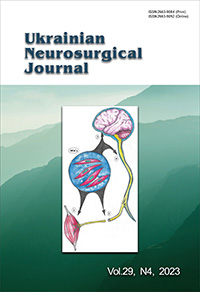Comparative assessment of methods of the operative treatment of facial nerve damage caused during cerebellopontine angle neurinoma and meningioma removals
DOI:
https://doi.org/10.25305/unj.288270Keywords:
neurinoma, meningioma, facial nerve damageAbstract
The aim of this research paper is to point out the preconditions for facial nerve damage during CPA tumour removals and, in such cases, the appropriate choice of reconstructive surgery.
Materials and methods. In Uzhhorod National University, during the period of 2008 to 2019, surgical treatment of 212 patients with neurinomas and meningiomas of the CPA has been carried out. We have analyzed the cases of 35 (16.5%) patients with intraoperative damage of the facial nerve.
The mentioned 35 patients underwent appropriate clinical examinations during the post-operative period, which confirmed the facial nerve damage to one degree or another according to the House-Brackmann scale. The clinical signs manifested as full eyelid contact with slight effort and slight facial asymmetry during maximal effortful laughter. Slight synkinesias were noticeable, and there were no contractures until the expression of clinical signs corresponding to grade 6 - total nerve paralysis in 5 patients.
Results. The research demonstrated that patients with neurinomas larger than 3 cm in size are 5 times more likely to undergo intraoperative damage to the facial nerve than patients with the same tumour but 3 cm or less in size and 5 times more likely than patients with meningiomas as a whole.
In the group of patients aged 20-40, there were twice as many men; in the group aged 40-50, women predominated; among patients older than 50, there were equal numbers of men and women.
Remote catamnesis was traced in 19 patients, and contact with the rest of the patients was lost due to the war. Among the interviewed patients, 58% of the anastomosis was performed in the first 3 months after the initial surgery, 21% - in 4-6 months, and 21% - in more than 12 months.
The optimal timing of reinnervation after the initial surgery is the first 6 months after tumour removal.
Сonclusions. Nerve damage is more common during the removal of neurinomas 4cm or bigger in size. Reinnervation is accomplished by anastomosing the central end of the hypoglossal or accessory nerves to the peripheral end of the facial nerve, and both procedures are equally effective. Reinnervation should be performed 2 to 3 months after confirming nerve injury, but no later than 6 months.
References
1. Samii M, Gerganov VM. Tumors of the cerebellopontine angle. Handb Clin Neurol. 2012;105:633-9. [CrossRef] [PubMed]
2. Springborg JB, Poulsgaard L, Thomsen J. Nonvestibular schwannoma tumors in the cerebellopontine angle: a structured approach and management guidelines. Skull Base. 2008 Jul;18(4):217-27. [CrossRef] [PubMed] [PubMed Central]
3. Lak AM, Khan YS. Cerebellopontine Angle Cancer. [Updated 2023 Jun 26]. In: StatPearls [Internet]. Treasure Island (FL): StatPearls Publishing; 2023 Jan-. https://www.ncbi.nlm.nih.gov/books/NBK559116/
4. Izycka-Swieszewska E, Szurowska E, Kloc W, Rzepko R, Dubaniewicz-Wybieralska M, Skorek A, Drozyńska E, Stempniewicz M. Cerebellopontine angle tumours: radiologic-pathologic correlation and diagnostic difficulties. Folia Neuropathol. 2006;44(4):274-81. [PubMed]
5. Apostolakis S, Karagianni A, Mylonakis I, Vlachos K. Mass phenomena from a cerebellopontine angle arachnoid cyst: case report. Russian Journal of Neurosurgery. 2022 Jun 12;24(2):62–5. [CrossRef]
6. Foscolo V, de Gennaro L, Murri A, Speranzon L, Signorelli F, Quaranta N, Messina R. Postoperative Impact of Pontocerebellar Angle Surgery on the Quality of Life in Patients with Vestibular Schwannoma. Audiol Res. 2022 Nov 17;12(6):635-643. [CrossRef] [PubMed] [PubMed Central]
7. Yrysov KB, Shamshiev AT. [Results of surgical management for acoustic neurinomas using retrosigmoid approach]. Vestnik Kazahskogo nacionalʹnogo medicinskogo universiteta. 2015;(2):470-2. Russian.
8. Yrysov KB, Mamytov MM. [Analysis of the outcomes of surgical treatment of acoustic neuromas]. Journal of Siberian Medical Sciences. 2010;(6):5. Russian.
9. Ebersold MJ, Harner SG, Beatty CW, Harper CM Jr, Quast LM. Current results of the retrosigmoid approach to acoustic neurinoma. J Neurosurg. 1992 Jun;76(6):901-9. [CrossRef] [PubMed]
10. Mamytov MM, Yrysov KB. [Preservation of the functions of the facial and auditory nerves in surgery for neuromas of the VIII nerve]. Nauka o zhizni i zdorov'ye. 2013;(3):49-51. Russian.
11. Rhoton AL Jr. The cerebellopontine angle and posterior fossa cranial nerves by the retrosigmoid approach. Neurosurgery. 2000 Sep;47(3 Suppl):S93-129. [CrossRef] [PubMed]
12. Tatagiba M, Matthies C, Samii M. Microendoscopy of the internal auditory canal in vestibular schwannoma surgery. Neurosurgery. 1996 Apr;38(4):737-40. [CrossRef] [PubMed]
Downloads
Published
How to Cite
Issue
Section
License
Copyright (c) 2023 S.M. Yeghunyan, M.A. Yeghunyan

This work is licensed under a Creative Commons Attribution 4.0 International License.
Ukrainian Neurosurgical Journal abides by the CREATIVE COMMONS copyright rights and permissions for open access journals.
Authors, who are published in this Journal, agree to the following conditions:
1. The authors reserve the right to authorship of the work and pass the first publication right of this work to the Journal under the terms of Creative Commons Attribution License, which allows others to freely distribute the published research with the obligatory reference to the authors of the original work and the first publication of the work in this Journal.
2. The authors have the right to conclude separate supplement agreements that relate to non-exclusive work distribution in the form of which it has been published by the Journal (for example, to upload the work to the online storage of the Journal or publish it as part of a monograph), provided that the reference to the first publication of the work in this Journal is included.









